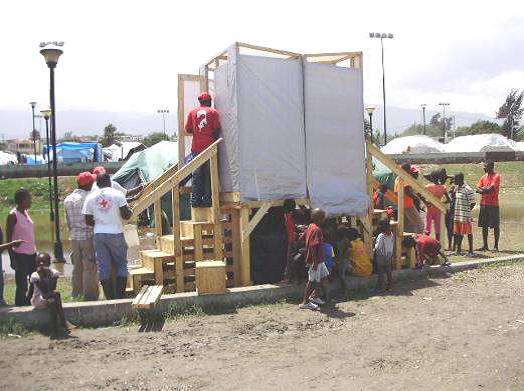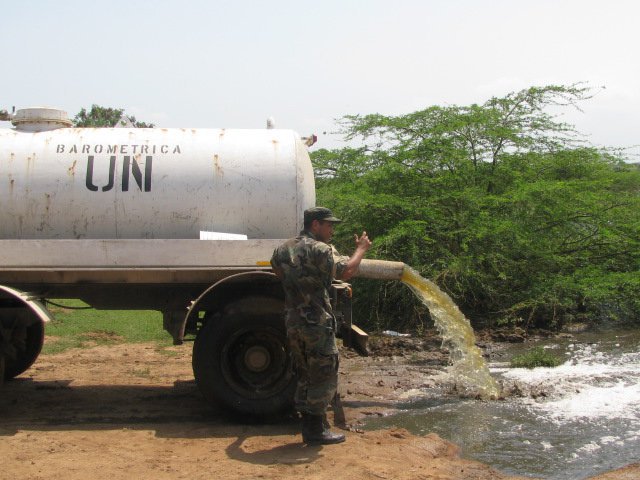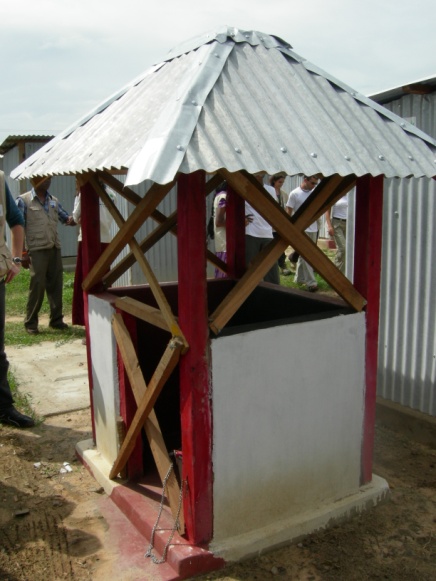Sustainable Sanitation for Emergencies and Reconstruction
Contents
- 1 Summary
- 2 Introduction
- 3 Shortcomings of current approaches
- 4 Resilient and robust sanitation systems
- 5 Consideration to groups with specific needs
- 6 Solutions for the immediate to short-term stages of an emergency
- 7 Solutions for the medium (recovery) to long-term stages of an emergency
- 8 Rehabilitation and disaster risk reduction
- 9 Feasibility for reuse of nutrients
- 10 Acknowledgements
Summary
Shortcomings of current approaches for emergency prevention and relief include: Insufficient resources invested in sanitation, lack of prioritisation of sustainable solutions, inadequate human resource capacity for urban sanitation in humanitarian agencies and lack of good governance for reducing disaster risks. The last issue particularly impacts the risk reduction potential of countries. To reduce the risk and potential effects of disasters, sanitation solutions need to be robust to buffer against certain challenging environments. In emergency situations, groups with specific needs need to be considered (i.e. children, women, elderly, injured and people with disabilities) and appropriate emergency relief measures for each stage of an emergency situation need to be selected.
We recommend the following to the actors in the emergency and reconstruction sectors
- Increase funding for sanitation in emergency and reconstruction situations with regards to software as well as hardware components.
- When implementing immediate sanitation solutions, apply those which can be adapted in later phases to become more permanent and sustainable.
- Use adequate sanitation options which are robust and can cope with challenging environments.
- Build capacity in local entrepreneurship for long-term self-help in the reconstruction phase.
- In between emergencies incorporate risk reducing measures in local and urban planning which will prevent and reduce the need for response efforts.
- Engage in learning activities and experiment together with other professionals to increase innovation of options.
Introduction
Sustainable sanitation systems take into consideration aspects of health, environmental resources, economic viability and socio-cultural acceptance as well as technical and institutional appropriateness (SuSanA, 2008).Sustainable sanitation systems in emergencies also require examining the resilience and robustness of existing systems to function during the entire emergency. For example, disaster situations often present additional challenges of difficult environments, such as flooding, lack of transport and access of materials. There are also challenges of a traumatised and injured population and disruption of societal functions exposing vulnerable people to even more health risks.
Sustainable solutions also have to manage the transition into a post-disaster phase and future development, and assure that immediate measures do not create unwanted health hazards or other undesirable consequences in the longer term. Many humanitarian actors (mostly NGOs, UN, unilateral aid, etc.) acknowledge that current sanitation practices are often not sufficient.
There is a need for innovation through interaction with experts who are not normally involved in emergency responses, such as private manufacturers, urban sanitation engineers, and industrial designers. This exchange and learning is not that easy as the various actors involved in disaster response usually have little time for networking, research and updating their expertise on other systems. The SuSanA Working Group 8 is aiming to act as an open platform to bring people together with the purpose of pushing towards more sustainable solutions and information exchange.
Shortcomings of current approaches
For more details kindly see the factsheet.
- Insufficient resources invested in sanitation: The great focus on water supply in emergencies has made sanitation a forgotten area.
- Lack of prioritisation of sustainable solutions: Due to the focus on speed and quantity, sustainable solutions are often not prioritised. In the height of an emergency, options are applied as short term measures (e.g. trench latrines).
- Inadequate human resource capacity in humanitarian agencies for urban sanitation: There is an increasing number of urban disasters. At the same time humanitarian agencies have inadequate human resource capacity to implement urban sanitation solutions.
- Lack of good governance for reducing disaster risk: Bad governance, poverty and corruption make a population very vulnerable to disaster.
Resilient and robust sanitation systems
Natural hazards such as extreme rainfall (leading to floods) and earthquakes do not necessarily result in disasters. They only turn into disasters when human society is unprepared for them, where infrastructure and planning has not been designed to withstand or buffer against them and if society cannot respond or learn adequately.Solutions need to be robust to buffer against certain challenging environments which include for example:
- Unstable soils (e.g. sandy soils) make the lining of pits necessary to prevent them from collapsing.
- High groundwater tables and flooding cause problems with the containment of the excreta. Potential solutions include sealed pits or above ground structures.
- Rocky soils make digging difficult and uneven geology (e.g. sand mixed with rocks) increases risks of groundwater pollution with pathogens and nitrate.
- Spatial constraints mainly in urban areas where the construction, replacement and maintenance of toilets, as well as pit emptying, is restricted due to a high population density.
Resilient systems also involve the adaptive (social) capacity to learn, adapt and self-organise (Folke, 2006). When disasters occur, informal social structures are important, and in most cases government bodies and local volunteers from organisations such as Red Cross/Red Crescent are early on site and mobilised quickly.
Apart from robust technology or “hardware solutions”, appropriate “software methods” that engage target groups, create demand for services and encourage the change of behaviours also need to be applied (examples in the factsheet).
Interventions in emergencies tend to be managed well when they are implemented by dedicated groups of staff working with small communities with whom they develop clear reciprocal relationships and understanding. Local NGOs already active in the area are often invaluable in mobilising and reaching local communities and building their trust.
Consideration to groups with specific needs
Further specifications are to be found in the original factsheet.
- Children
- Women
- People with disabilities, elderly or injured people
Solutions for the immediate to short-term stages of an emergency
Top priority in immediate emergencies is containing excreta as fast as possible. Defecation fields are frequently mentioned in the literature but are not often implemented. Often the implemented minimum standard is a simple pit latrine structure. In addition, it is necessary to equip each toilet or block of toilets with a hand washing facility with soap. Desludging and safe disposal of the collected excreta is crucial for the mitigation of health risks but is often very challenging.
Humanitarian agencies have realised that the more permanent these initial structures are, the better. They also recognise that the first 1-2 weeks are the most critical as this is the time when there is a big gap in suitable technologies even without considering aspects of sustainability.
In the following some of these sustainable immediate solutions are described.
a) Biodegradable plastic bags
Biodegradable bags can be inserted into a locally available small container to create individual toilets or to be used as part of a communal facility. During emergencies, biodegradable bags could help address the time needed to construct adequate latrines or where traditional options cannot be utilised, or if there are gaps in coverage (for household-level use especially by people with disabilities, children and women at night). Proper burial or collection for a composting system must be ensured to make it a hygienically safe system. Further research is needed regarding the cost effectiveness over time and phase-out points or upgrading strategies.
b) Emergency urine diversion toilet slab
The prefabricated plastic toilet slab for immediate dispatch is central in an emergency, as other toilet parts are often locally available. Some humanitarian agencies have taken measures to diversify the standard squatting slab by adding a urine diversion part to separate urine and faeces.
The urine diversion slab allows for immediate separation of urine. By reducing the liquid content the time that the toilet can be used for – before the container or pit fills up – is prolonged. Separating urine also accelerates the drying process of faecal matter and reduces odour and flies. Urine does not necessarily have to be reused if the only aim of the separation is to reduce volume of faecal waste, and reduce odour and flies.
c) Raised toilets with or without urine diversion
The raised toilet is appropriate when it is physically not possible to dig into the soil (hard surfaces) or land ownership prohibits digging. Disadvantages of raised toilets include relatively slow and costly installation and the need for more frequent desludging than toilet options dug into the ground where all liquids are allowed to infiltrate (Johannessen, 2011).
d) Waterless urinals
Urinals are useful for keeping liquids out of the toilet pit, thus extending the period it takes to fill the pit. Where appropriate, the urine can be reused as fertiliser for crops following existing urine reuse guidelines
e) Trench latrines and other wet toilet systems
Often excreta are buried in deep trench latrines. If water is available, wet systems such as pour flush pit latrines, may be selected. In any case, the most important aspect from a sustainability point of view is to design and place the latrines in a way to avoid groundwater contamination. Drainage or spillage from latrines must not run towards any surface water source or shallow groundwater source.
f) Desludging and disposal
Desludging is necessary when the containers or pits of toilets are full, and is often done by a fleet of vacuum trucks. There are also manual desludging pumps. A big gap in emergencies is the safe disposal and management of the faecal sludge once emptied from the toilet facilities.
Solutions for the medium (recovery) to long-term stages of an emergency
In the medium (6-12 months) to long-term (>1 year) stage of an emergency the situation is stabilised and emergency toilets can be turned into more permanent structures. Ideally, the immediate solutions should be suitable to be adapted. Some examples of sanitation systems used in the past during the recovery or long-term stages include:
- Larger communal glass fibre systems
- Biogas sanitation
- Fossa Alterna with two alternating pits
- Raised UDDTs
Rehabilitation and disaster risk reduction
Re-building better after a disaster reduces risks from recurring hazards such as floods. Rehabilitation in urban areas poses very different technical challenges than those in rural environments, but can also be an opportunity. Disasters can thus act like a “wake up” call to trigger more investment in risk reduction, which also decreases the need for response in the future. A lack of risk reduction prior to a disaster makes the response more difficult after a disaster.
The solutions developed can provide livelihood opportunities in local communities for organisations like health clubs, women clubs, artisans, operators, manufacturers and the list goes on. A prime example being the production of toilet slabs which can be set up a few weeks after the disaster event. The motivation and social mobilisation is crucial for successful reconstruction, which also involves reconstructing the local economy and society.
Feasibility for reuse of nutrients
In the past, UDDTs have been used for sanitation provision during and after the emergency situation. The UDDTs, without reuse activities, were successfully applied in the long-term phase of the emergency with a possibility that the reuse function could be activated later if demanded or feasible (Mwase, 2006)
Enabling environment for reuse of treated excreta:
- Where growing crops is possible. There is often some kind of agricultural activity in refugee camps.
- Social acceptance is needed.
- When it is feasible to educate, train and manage the facilities properly, preferably in collaboration with local agricultural extension workers.
- Reuse is mainly a household option, but could also be practiced at a communal level if managed correctly by following the existing WHO guidelines on the safe use of excreta in agriculture. Health risks from reuse activities are lower within a single family system compared to communal toilets and where the fertiliser produced or fertilised products are sold to others.
Acknowledgements
SuSanA factsheet: Sustainable sanitation for emergencies and reconstruction situations. April 2012. susana.org







